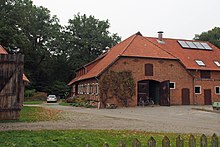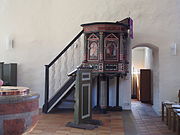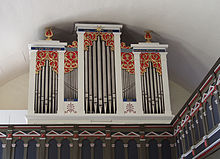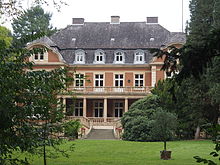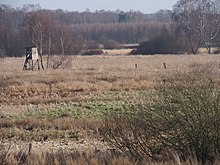Eldingen
| coat of arms | Germany map | |
|---|---|---|

|
Coordinates: 52 ° 41 ′ N , 10 ° 21 ′ E |
|
| Basic data | ||
| State : | Lower Saxony | |
| County : | Celle | |
| Joint municipality : | Lachendorf | |
| Height : | 71 m above sea level NHN | |
| Area : | 56.73 km 2 | |
| Residents: | 1996 (December 31, 2019) | |
| Population density : | 35 inhabitants per km 2 | |
| Postal code : | 29351 | |
| Area code : | 05148 | |
| License plate : | CE | |
| Community key : | 03 3 51 008 | |
| Community structure: | 9 districts | |
| Association administration address: | Oppershäuser Str. 1 29331 Lachendorf |
|
| Website : | ||
| Mayor : | Hans-Joachim Lübbe | |
| Location of the municipality of Eldingen in the district of Celle | ||
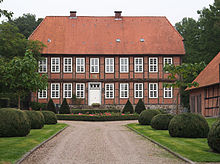
Eldingen is a political municipality on the southern edge of the Lüneburg Heath and within the boundaries of the Südheide Nature Park and on the eastern edge of the district of Celle ( Lower Saxony ). It is the largest in terms of area and the second largest in terms of population in the Lachendorf municipality .
geography
Geographical location
The municipality is traversed by the Lutter , which absorbs the Schmalwasser and Köttelbeck in the district of Bargfeld . In the southeast the municipality borders on the Lachte .
Neighboring communities
- Steinhorst (Distance: 4.5 km)
- Beedenbostel (Distance: 6.7 km)
- Ahnsbeck (Distance: 7.7 km)
- Eschede (Distance: 7.9 km)
- Lachendorf (Distance: 9.3 km)
Community structure
Eldingen consists of the districts (in brackets: population figures 2005)
- Eldingen (995)
- Bargfeld (188)
- Grebshorn (164)
- Heese (54)
- Hohnhorst (258)
- Sucking (83)
- Metzingen (360)
- Wohlenrode (343)
- Brickyard (68)
history
Eldingen was first mentioned in 1231 as Elthinge .
In 1543 the village became Protestant. As the seat of the Lords of Elding, but also with several free courtyards (later " Meierhöfen ") and as a church village, it survived the Thirty Years' War with numerous contributions and looting, but without destruction. The feudal estate passed to the von der Wense family in the middle of the 17th century . In the dispute between the Realgemeinde about wood rights, a “pig war” broke out in 1668 with the eastern neighboring village of Steinhorst (one dead). In 1849 the peasants were liberated in Eldingen and the estate lost its special rights to farm services. On October 1, 1890, the town center burned down completely.
The conservative population, who remained loyal to the welf for a long time after the Prussian occupation of the Kingdom of Hanover in 1866 (Reichstag election in 1928: 40.1 percent for the German-Hanover party ), voted predominantly National Socialist (43.2 percent) as early as 1930 . On August 16, 1904, Eldingen got a train station with the commissioning of the Celle – Wittingen small railway and modest economic growth began.
The Eldingen volunteer fire brigade was founded on March 18, 1904.
In 1943, numerous Hamburg bomb victims were quartered. In World War II, 46 villagers were killed as soldiers. In 1945 Friedrich Knoop prevented the demolition of the narrow bridge over the Lutter, ordered by the Volkssturm . The strong influx of refugees in 1945 made high demands on the community.
Decades after the unplanned increase in importance, there has been a decline in importance since 1970 due to a sharp decline in business.
The local trade, which was still quite differentiated in terms of craft businesses, shops and restaurants in 1973, has since declined sharply in all districts, as has the number of farms operated as full-time businesses. However, four small publishing houses are now based in the Bargfeld district.
Incorporations
With the law on the reorganization of the communities in the district of Celle of December 4, 1972, which came into effect on January 1, 1973, the villages (now districts) Bargfeld , Grebshorn, Heese, Hohnhorst, Luttern, Metzingen and Wohlenrode became part of the municipality Eldingen incorporated, which came to the joint municipality of Lachendorf .
Religions
Most of the residents are Protestant . They belong to the parish office of Eldingen of the Evangelical Lutheran Church in Hanover with church buildings in Eldingen and Hohnhorst, the parish hall and churchyard in Eldingen.
politics
Municipal council
The council of the municipality of Eldingen consists of 13 members.
| Common list Eldingen | CDU | SPD | FWG | FDP | total | |
| 2001 | 7th | 6th | 0 | 0 | 0 | 13 seats |
| 2006 | 7th | 3 | 0 | 3 | 0 | 13 seats |
| 2011 | 10 | 3 | 0 | 0 | 0 | 13 seats |
last local election on September 11, 2011
coat of arms
Blazon : "Split and half-divided on the right, a silver ploughshare in green above , half a right silver mill wheel in blue, an upright lion in red on the left over a lowered wave bar, both silver."
Culture and sights
Museums
In the district of Bargfeld there is the Arno Schmidt Museum of the Arno Schmidt Foundation, which is domiciled there, and the permanent exhibition of the photo installation "End of the Pig War between Eldingen and Steinhorst" by photographer Marion Gülzow (as part of the "Magical Places in the Südheide" campaign) at the Bangemann inn.
music
Concerts are sometimes given in the Marienkirche.
Buildings
Saint Mary's Church
The Evangelical Lutheran Church of St. Mary is mentioned indirectly in the document from 1231, but its present form largely dates from the 14th century . Apart from the younger west gable, the nave consists almost entirely of field stone . The portal in the middle of the north wall with its walls made of red and black glazed brick is in all likelihood also medieval and thus a testimony to the brick Gothic . Some of the Gothic lancet windows are also made of brick, but without any aesthetic effort. The roof structure with the wooden barrel ceiling was built in the 17th or 18th century. The western porch was built in the 19th century, the northern one around 1900. Both are therefore to be assigned to the neo-Gothic . At times there was also a vestibule in front of the brick-lined portal. The church has a free-standing wooden bell tower with a clock on the north and west sides. It houses three bronze bells from 1953. The old bell from 1465 was cracked in 1952. The tower had to be moved a few meters in 1969 because of the construction of the Celle - Wittingen road .
Inside the church there is a valuable carved altar from around 1425. In front of the altar is a Romanesque font from the previous building mentioned in 1231. The silver pair of candlesticks dates from the second half of the 17th century. The carved pulpit from the end of the 16th century carries paintings of the four evangelists in frames, which are designed like Renaissance portals. The gallery , designed to echo the pulpit, extends on the west and north walls. Opposite, on the south wall, hangs a wooden crucifix almost two meters high.
The church has the only one still largely preserved old Eduard Meyer - Organ in the church district Celle. It was built in 1853 with 16 stops on two manuals and a pedal . In 1917 the original prospect pipes had to be handed in as material for the First World War . In the meantime, however, the instrument has corresponding replacement pipes again . In the middle of the 20th century, the organ was changed and its sound distorted during drastic renovations. In 2012 it was renovated by the organ building workshop Udo Feopentow through extensive restoration work.
|
|
|
||||||||||||||||||||||||||||||||||||||||||||||||||||||||||||||||||||||||||||||||||||||||||||||||||||||||||||||||||||
- Secondary register : Tremulant (additional), Zimbelstern (original), Calcant
- Swell step : (can also be operated by hand as a register "Forte II, Man.")
Boulder
A large boulder with the inscription "750 years of Eldingen 1995" stands as a memorial in the center of the village. Due to the first documentary mention of October 31, 1231 (see history), "750 years of Eldingen" can be predated to 1981. At the north-western exit of the town there is a memorial in honor of those who fell in the First and Second World Wars .
Eldingen Castle
Eldingen Castle, a manor house , built between 1904–1907 in neo-baroque style according to plans by the architect Hermann Schaedtler for Baron Walther Johannes von Caron (1855–1937), the brother of Albert von Caron . In August / September 2008, the castle also served as the backdrop for the film Berlin 36 . In 2010, Hans Gebhard von der Wense acquired the Eldinger castle with a right of first refusal in order to then sell it on to the ECM company. In the following years it was renovated and restored by private investors, today the rooms of the castle can be rented for conferences, trade fairs or celebrations (e.g. weddings). The Winter Dreams event takes place here every year, at which sophisticated home decor, art and design, antiques, jewelry, country house fashions and winter decorations from all over the world are presented by around 160 exhibitors. The winter dreams attract thousands of visitors to Eldingen every year.
Architectural monuments
Large-scale conservation project
Large parts of the district fall into the " Lutter nature reserve ". This major nature conservation project was funded by the Federal Agency for Nature Conservation , the State of Lower Saxony and the districts of Celle and Gifhorn from 1989 to 2006 with 16.5 million euros.
Sports
Eldingen has a sports field and a gym, in Eldingen the Eldingen sports association from 1957 and the Eldingen shooting club from 1862 .
The airfield “Glider Airfield - Berliner Heide” is located in the Metzingen district. The Flugtechnische Verein Metzingen e. V. looks after him and also trains young people and adults in gliding.
Regular events
Easter bonfires are still common.
The club Einigkeit Bargfeld, founded in 1891, organizes its multi-day Faslam every February with a costumed pageant through the village and social events. Every year in late autumn, the Bargfeld Volunteer Fire Brigade organizes its Bargfeld torch and lantern parade with music for children and parents.
For over 25 years, the Eldingen sports community has been organizing its sports week from the third to the fourth weekend in July, which culminates in the “Blue-White Night” at the end of the week.
The “Bean Cup” has gained a large number of visitors and is well known beyond the region in recent years. The leisure football team "Schluck die Bohne" Bargfeld organizes this hobby tournament every year at the end of June on the Eldinger sports field.
Economy and Infrastructure
Economy and resident companies
The number of full-time farms has fallen sharply; the part-time farmer has become typical. The rural women association Eldingen (chairman 2009: Dörte Stellmacher) organizes exchanges of experiences and educational trips; Local trustees work in the districts.
There is a post office in the district of Eldingen . In the district of Barg field, the Antiquarian is the Bücherhaus . Shops in the form of a small supermarket with a bakery in the town center can be found as well as a local gas station chain.
traffic
A line of the East Hanoverian Railways with a train station in Eldingen runs from Celle to Wittingen , but has suspended passenger traffic with the exception of a museum railway. The state road 282 from Celle crosses Eldingen in a west-east direction and ends further east at the B 4. The state road 283 runs in a north-south direction through Eldingen.
Public facilities
An administrative office of the Lachendorf joint municipality is located at Schulstrasse 11.
The local fire brigades Bargfeld, Eldingen, Hohnhorst and Metzingen are involved in the district fire service of the Celle district. They provide fire protection and general help in the community area.
education
The primary school (proven since before 1765, catchment area the districts of Bargfeld, Eldingen, Grebshorn, Heese, Hohnhorst), the Gerd-Wilhelm-Rotermund community library and the kindergarten are located in the district of Eldingen. The other districts are approached by the mobile library of the district of Celle every 14 days.
Personalities
Personalities from Eldingen and its districts
- August von der Wense (born August 6, 1792 in Wohlenrode, † August 27, 1867 in Holdenstedt ), administrative lawyer and royal Hanoverian Drost and district administrator
- Heinrich Severloh (* 1923 in Metzingen; † 2006 in Lachendorf), farmer's son, then in 1944 Wehrmacht soldier and a well-known machine gunner on Omaha Beach
Personalities who have worked on site
In the then still independent political communities lived:
Bargfeld:
- Gotthelf Schlotter , (born December 24, 1922 in Hildesheim , † August 4, 2007 in Darmstadt ), sculptor
- Alice Schmidt (born June 24, 1916 in Greiffenberg ; † August 1, 1983 in Bargfeld), writer
- Arno Schmidt (born January 18, 1914 in Hamburg-Hamm , † June 3, 1979 in Celle), writer and translator
Eldingen:
- Hermann von Boetticher (born August 13, 1887 in Eldingen; † 1941 presumably in Sonnenstein Castle ) writer and dramaturge
Metzingen OT brick factory:
- Kurt Mühlenhaupt (born January 19, 1921 in Klein Ziescht ; † April 16, 2006 in Bergsdorf ), painter
In Eldingen lives:
- Bernd Rauschenbach (born July 30, 1952 in Berlin ), literary scholar
literature
- Gerhard Drangmeister: 100 years around the Eldinger School, 1820–1920 . 135 p., Eldingen 1996.
- Adolf Meyer: Eldingen I , 460 S., Eldingen 2002.
- Adolf Meyer: Eldingen II , 602 S., Eldingen 2003.
- Adolf Meyer: Grebshorn , 401 S., Eldingen 1990.
- Adolf Meyer: Heese and Luttern , 484 S., Eldingen 2000.
- Adolf Meyer: Hohnhorst , 440 S., Eldingen 1995.
- Adolf Meyer: Metzingen , 502 S., Eldingen 1982.
- Adolf Meyer: Wohlenrode , 498 S., Eldingen 1993.
- Adolf Meyer: Bargfeld , 556 S., Eldingen 1997.
- Matthias Blazek: The history of the music train of the volunteer fire brigade Eldingen 1910-2010 , 112 S., Eldingen: Oesselmann 2010, ISBN 978-3-00-029234-7 .
- Matthias Blazek: Genealogy on the villages , in: Goslarer Bergkalender , 393rd year 2011, Goslar 2010, p. 105 ff.
Web links
- Short film about Eldingen, 1:31 minutes
- Homepage of the district of Luttern
- Information for the region
Individual evidence
- ↑ State Office for Statistics Lower Saxony, LSN-Online regional database, Table 12411: Update of the population, as of December 31, 2019 ( help ).
- ↑ For a long time 1245 was considered the year of the first documentary mention. This is overtaken by the discovery of a document (original, State Archives Wolfenbüttel 24, document 62) of the Katlenburg monastery from October 28, 1231. The certificate with seal documents that Provost Ludolf, Prioress Jutta and the convent of the Katlenburg or Riddagshausen monastery sold a Hufe zu Schapen ( Scepen ) to the church in Eldingen ( Elthinge ) for one mark of Brunswick coin . The contract came about through the mediation of the brother Alradus (Alrad) von Eldingen of a conversation in Riddagshausen. Further details in: Sachsenspiegel 52, Cellesche Zeitung , December 30, 2006.
- ^ Federal Statistical Office (ed.): Historical municipality directory for the Federal Republic of Germany. Name, border and key number changes in municipalities, counties and administrative districts from May 27, 1970 to December 31, 1982 . W. Kohlhammer GmbH, Stuttgart and Mainz 1983, ISBN 3-17-003263-1 , p. 223 .
- ↑ Preliminary results of the district and municipal elections as a PDF document 2.90 MB ( Memento of the original from January 11, 2016 in the Internet Archive ) Info: The archive link was inserted automatically and has not yet been checked. Please check the original and archive link according to the instructions and then remove this notice.
- ↑ http://www.nomine.net/eldingen-st-marien | pdf archive date = 2014-03-12
- ↑ Cordula Steffen-Hammes, The Palace Buildings by the Architect Hermann Schaedtler from 1888-1927, Rheinische Friedrich-Wilhelms-Universität zu Bonn, 1996.
- ↑ Eldingen Castle .
- ↑ Schloss Eldingen at lostplaces .
- ↑ [1]






